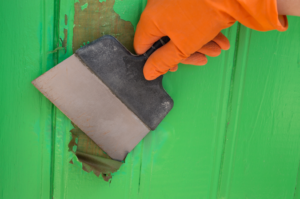Why Do I Need to Remove Existing Paint Before Repainting My Home’s Exterior?
June 6, 2024

If you’re gearing up to repaint your home’s exterior, you’re probably feeling pretty excited about the prospect of radically transforming your house. However, before getting started, there’s one crucial step that you’ll want to take: the removal of your old paint. Though it might not seem like a huge deal, failing to remove existing paint can end up altering or even ruining your new coat of paint. Here’s what you need to know.
1. Identify the Cause of Paint Failure
If you’re repainting your home’s exterior due to failing paint, rather than a change in preferences, you’ll need to consider why the paint is failing in the first place. Many factors lead to paint failure, such as interior moisture migrating through your walls, or poor flashing installation around windows. It might also simply be due to unexpected damage, such as from a sudden storm.
Needless to say, these issues need to be addressed before you apply a new coat of paint; otherwise, you’ll find yourself in a similar situation and your paint failing in the near future. Removing your old paint beforehand allows you to identify any potential issues with your home that would negatively impact your results!
2. Use Appropriate Paint Removal Methods
There are different methods for removing paint; for example, thermal methods tend to work well when you’re removing multiple layers of paint. This technique is simple; heat the paint until it bubbles and then scrape it away. Do not use a blow torch for this or any other tool that emits high-temperature flames; instead, use a heat gun or infrared heater, which both operate at much safer temperatures. The ideal temperature range for removing paint is between 500 – 800 Fahrenheit; anything higher risks vaporizing the paint and damaging the underlying wall.
Chemical paint strippers are another option; these products differ in quality and ingredients, and while they can get the job done, they tend to create a mess and pose a safety hazard. However, if you’re looking for a method other than heat removal, consider an abrasive technique involving sanding, shaving, or scraping. There are specialized tools you can buy that are designed for this. Just keep in mind that this technique is less ideal for larger zones and better suited for prepping spotty areas.
3. Don’t Neglect Clean-Up
All these methods of paint removal should be considered since every painting project is different. That said, no matter what method you select, it’s crucial that you properly clean the area beforehand, but especially afterward. Ensure that the surface is clean, full, and dry before your new paint is applied, and if there are any lingering flakes or bits of paint debris, clear them away—do not simply paint over them! Ensure that your landscaping, lawn ornaments, or other types of decoration are protected from old and new paint alike. And of course, you also should properly dispose of all paint so that it doesn’t become litter.
About Platinum Painting
Here at Platinum Painting, we’ve proudly served the painting needs of homeowners in the DFW metroplex for over 15 years, and we’d be honored to assist you with your upcoming exterior painting project! If you have any questions about the blog, or you’d like to get in touch with our team to set up a FREE in-home estimate, simply give us a call or reach out online for further information or assistance.
Tarrant County Telephone: (817) 697-2726.
Dallas/Denton/Collin County Telephone: (817) 993-4095.
